The Cambridge History of Japan, Vol. 3: Medieval Japan
Подождите немного. Документ загружается.

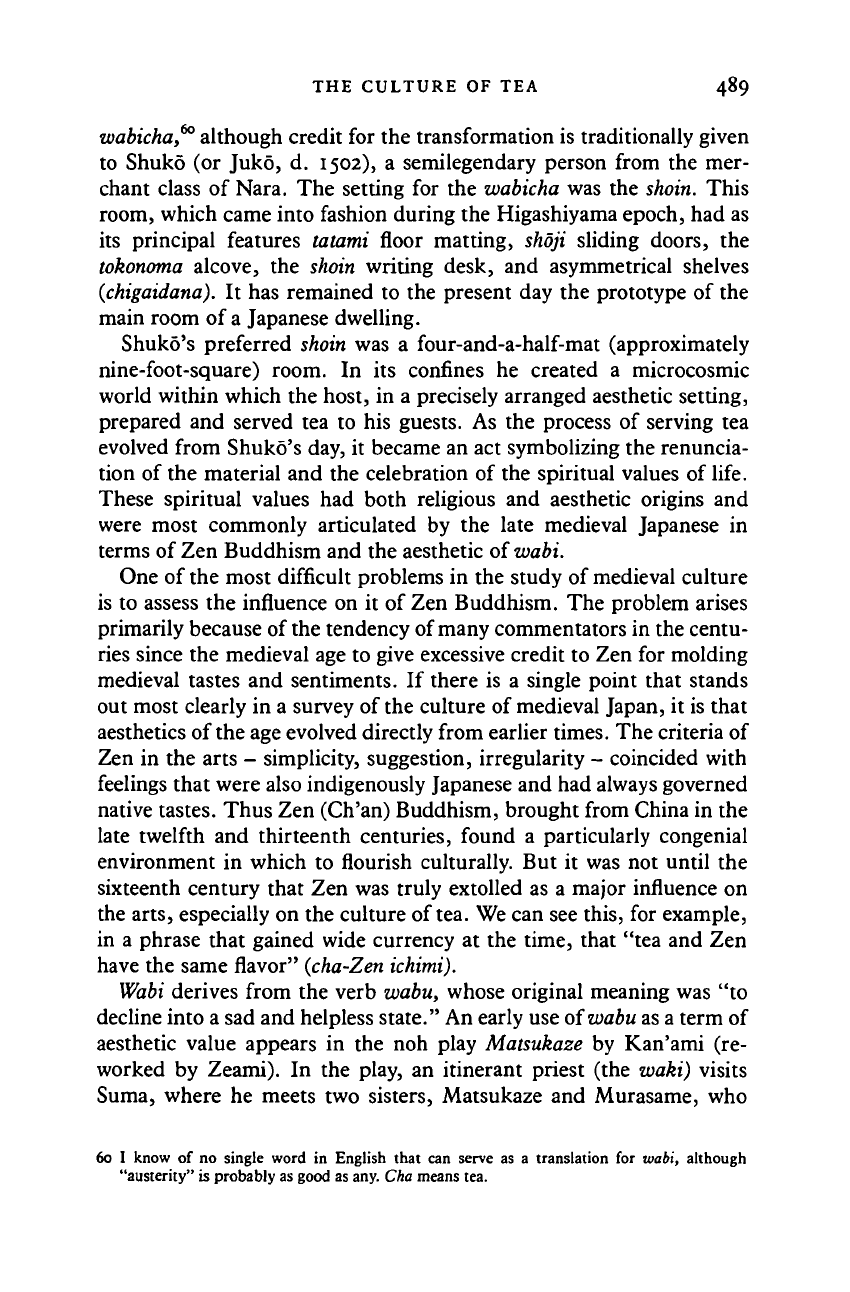
THE CULTURE OF TEA 489
wabicha,
60
although credit for the transformation is traditionally given
to Shuko (or Juko, d. 1502), a semilegendary person from the mer-
chant class of Nara. The setting for the wabicha was the shoin. This
room, which came into fashion during the Higashiyama epoch, had as
its principal features tatami floor matting, shqji sliding doors, the
tokonotna alcove, the shoin writing desk, and asymmetrical shelves
(chigaidana). It has remained to the present day the prototype of the
main room of a Japanese dwelling.
Shuko's preferred shoin was a four-and-a-half-mat (approximately
nine-foot-square) room. In its confines he created a microcosmic
world within which the host, in a precisely arranged aesthetic setting,
prepared and served tea to his guests. As the process of serving tea
evolved from Shuko's day, it became an act symbolizing the renuncia-
tion of the material and the celebration of the spiritual values of life.
These spiritual values had both religious and aesthetic origins and
were most commonly articulated by the late medieval Japanese in
terms of Zen Buddhism and the aesthetic of wabi.
One of the most difficult problems in the study of medieval culture
is to assess the influence on it of Zen Buddhism. The problem arises
primarily because of the tendency of many commentators in the centu-
ries since the medieval age to give excessive credit to Zen for molding
medieval tastes and sentiments. If there is a single point that stands
out most clearly in a survey of the culture of medieval Japan, it is that
aesthetics of the age evolved directly from earlier times. The criteria of
Zen in the arts - simplicity, suggestion, irregularity - coincided with
feelings that were also indigenously Japanese and had always governed
native tastes. Thus Zen (Ch'an) Buddhism, brought from China in the
late twelfth and thirteenth centuries, found a particularly congenial
environment in which to flourish culturally. But it was not until the
sixteenth century that Zen was truly extolled as a major influence on
the arts, especially on the culture of tea. We can see this, for example,
in a phrase that gained wide currency at the time, that "tea and Zen
have the same flavor" (cha-Zen ichimi).
Wabi derives from the verb wabu, whose original meaning was "to
decline into a sad and helpless state." An early use of wabu as a term of
aesthetic value appears in the noh play Matsukaze by Kan'ami (re-
worked by Zeami). In the play, an itinerant priest (the waki) visits
Suma, where he meets two sisters, Matsukaze and Murasame, who
60 I know of no single word in English that can serve as a translation for wabi, although
"austerity" is probably as good as any. Cha means tea.
Cambridge Histories Online © Cambridge University Press, 2008
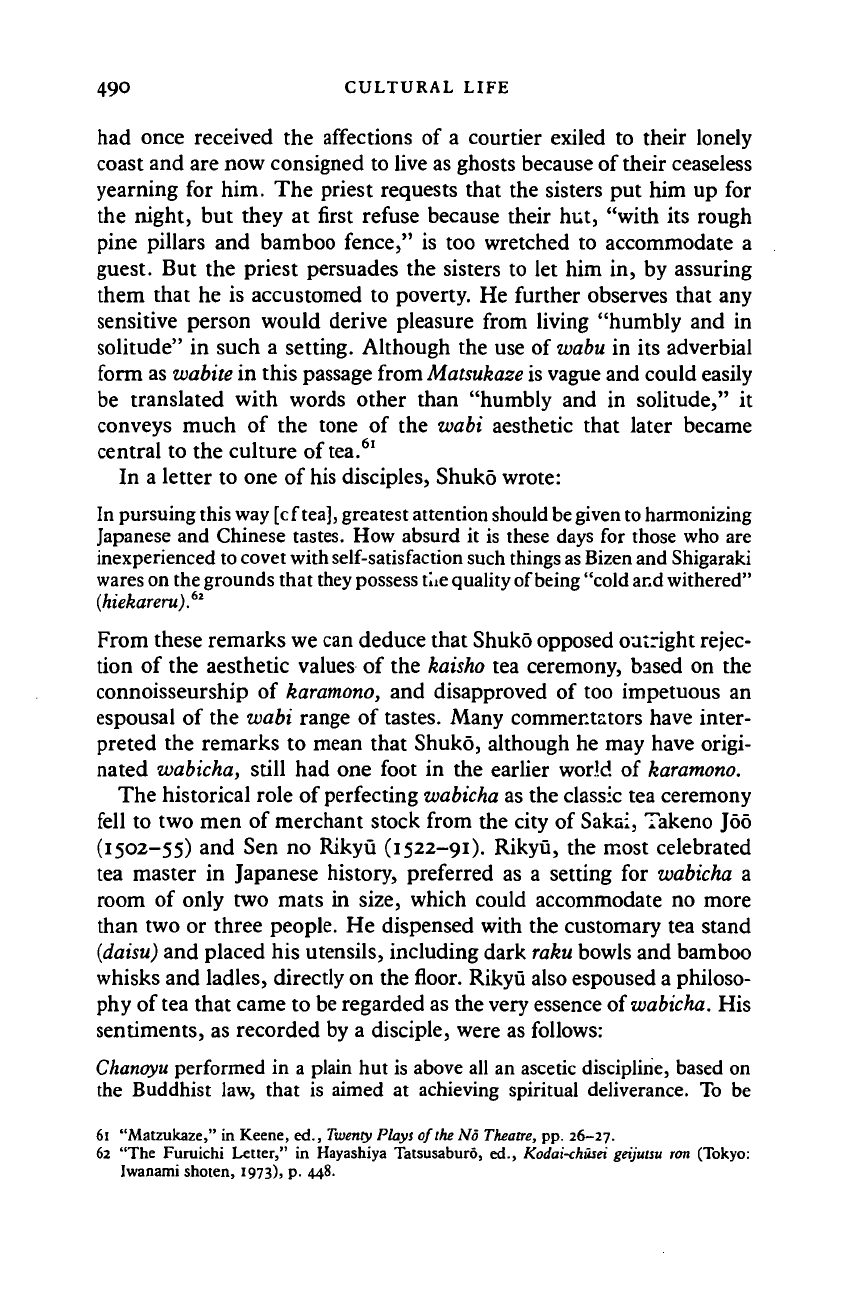
490 CULTURAL LIFE
had once received the affections of a courtier exiled to their lonely
coast and are now consigned to live as ghosts because of their ceaseless
yearning for him. The priest requests that the sisters put him up for
the night, but they at first refuse because their hut, "with its rough
pine pillars and bamboo fence," is too wretched to accommodate a
guest. But the priest persuades the sisters to let him in, by assuring
them that he is accustomed to poverty. He further observes that any
sensitive person would derive pleasure from living "humbly and in
solitude" in such a setting. Although the use of wabu in its adverbial
form as zvabite in this passage from Matsukaze is vague and could easily
be translated with words other than "humbly and in solitude," it
conveys much of the tone of the wabi aesthetic that later became
central to the culture of tea.
61
In a letter to one of his disciples, Shuko wrote:
In pursuing this way [cf
tea],
greatest attention should
be
given
to
harmonizing
Japanese and Chinese tastes. How absurd it is these days for those who are
inexperienced
to
covet with self-satisfaction such things
as Bizen
and Shigaraki
wares
on the grounds that they possess
tlie
quality of being "cold and withered"
(hiekareru).
62
From these remarks we can deduce that Shuko opposed outright rejec-
tion of the aesthetic values of the kaisho tea ceremony, based on the
connoisseurship of karamono, and disapproved of too impetuous an
espousal of the wabi range of tastes. Many commentators have inter-
preted the remarks to mean that Shuko, although he may have origi-
nated wabicha, still had one foot in the earlier world of karamono.
The historical role of perfecting wabicha as the classic tea ceremony
fell to two men of merchant stock from the city of Sakai, Takeno J66
(1502-55) and Sen no Rikyu (1522-91). Rikyu, the most celebrated
tea master in Japanese history, preferred as a setting for wabicha a
room of only two mats in size, which could accommodate no more
than two or three people. He dispensed with the customary tea stand
(daisu) and placed his utensils, including dark raku bowls and bamboo
whisks and ladles, directly on the floor. Rikyu also espoused a philoso-
phy of tea that came to be regarded as the very essence of wabicha. His
sentiments, as recorded by a disciple, were as follows:
Chanoyu
performed in a plain hut is above all an ascetic discipline, based on
the Buddhist law, that is aimed at achieving spiritual deliverance. To be
61 "Matzukaze," in Keene, ed.,
Twenty
Plays of the No
Theatre,
pp. 26-27.
62 "The Furuichi Letter," in Hayashiya Tatsusaburo, ed., Kodai-chusei geijutsu ton (Tokyo:
Iwanami shoten, 1973), p. 448.
Cambridge Histories Online © Cambridge University Press, 2008
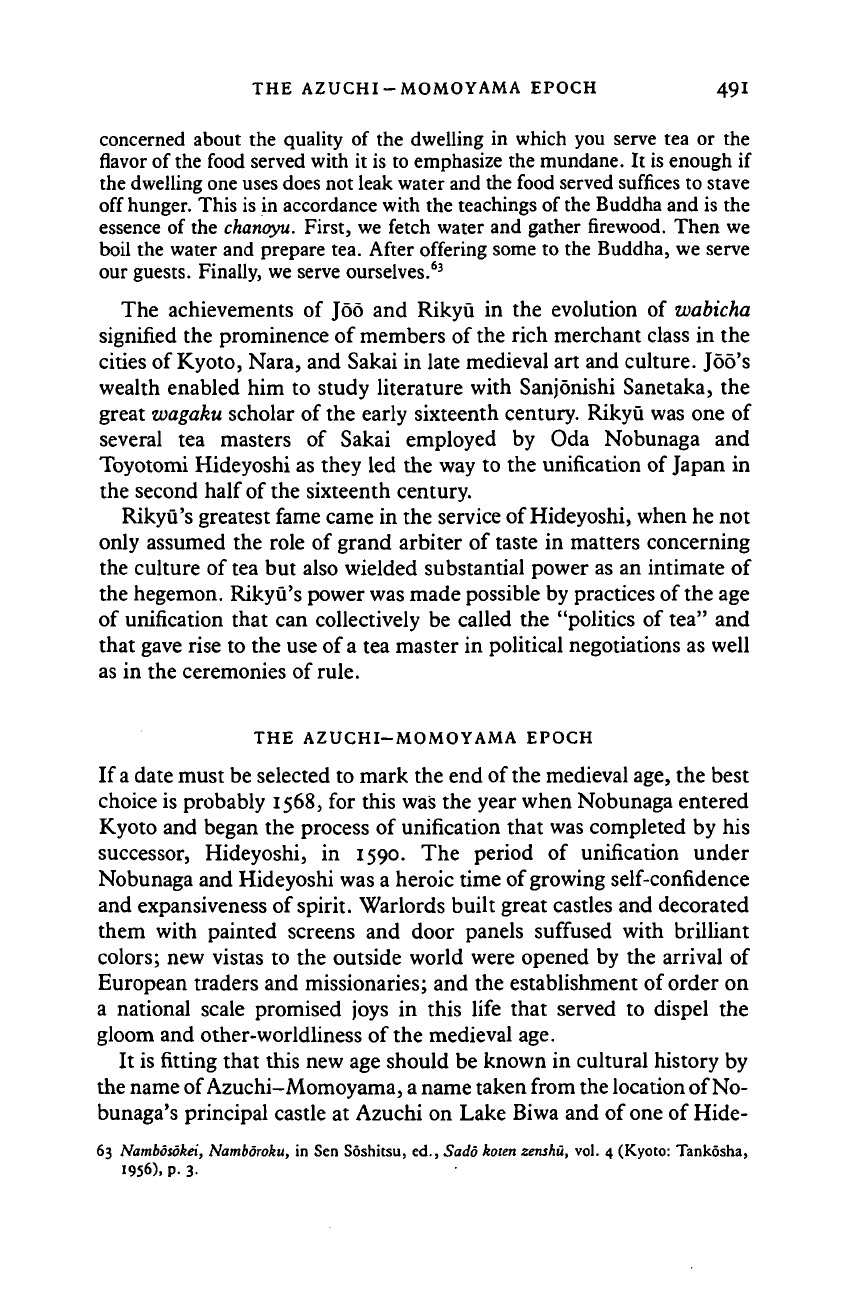
THE AZUCHI-MOMOYAMA EPOCH 491
concerned about the quality of the dwelling in which you serve tea or the
flavor of the food served with it is to emphasize the mundane. It is enough if
the dwelling one uses does not leak water and the food served suffices to stave
off
hunger.
This is in accordance with the teachings of the Buddha and is the
essence of the
chanoyu.
First, we fetch water and gather firewood. Then we
boil the water and prepare tea. After offering some to the Buddha, we serve
our guests. Finally, we serve ourselves.
63
The achievements of J66 and Rikyu in the evolution of wabicha
signified the prominence of members of the rich merchant class in the
cities of Kyoto, Nara, and Sakai in late medieval art and culture. Joo's
wealth enabled him to study literature with Sanjonishi Sanetaka, the
great wagaku scholar of the early sixteenth century. Rikyu was one of
several tea masters of Sakai employed by Oda Nobunaga and
Toyotomi Hideyoshi as they led the way to the unification of Japan in
the second half of the sixteenth century.
Rikyu's greatest fame came in the service of Hideyoshi, when he not
only assumed the role of grand arbiter of taste in matters concerning
the culture of tea but also wielded substantial power as an intimate of
the hegemon. Rikyu's power was made possible by practices of the age
of unification that can collectively be called the "politics of tea" and
that gave rise to the use of a tea master in political negotiations as well
as in the ceremonies of rule.
THE AZUCHI-MOMOYAMA EPOCH
If
a
date must be selected to mark the end of the medieval age, the best
choice is probably 1568, for this was the year when Nobunaga entered
Kyoto and began the process of unification that was completed by his
successor, Hideyoshi, in 1590. The period of unification under
Nobunaga and Hideyoshi was a heroic time of growing self-confidence
and expansiveness of spirit. Warlords built great castles and decorated
them with painted screens and door panels suffused with brilliant
colors; new vistas to the outside world were opened by the arrival of
European traders and missionaries; and the establishment of order on
a national scale promised joys in this life that served to dispel the
gloom and other-worldliness of the medieval age.
It is fitting that this new age should be known in cultural history by
the name of Azuchi-Momoyama, a name taken from the location of
No-
bunaga's principal castle at Azuchi on Lake Biwa and of one of Hide-
63 Nambosokei, Namboroku, in Sen Soshitsu, ed., Sado koten zenshu, vol. 4 (Kyoto: Tankosha,
1956),
p. 3-
Cambridge Histories Online © Cambridge University Press, 2008
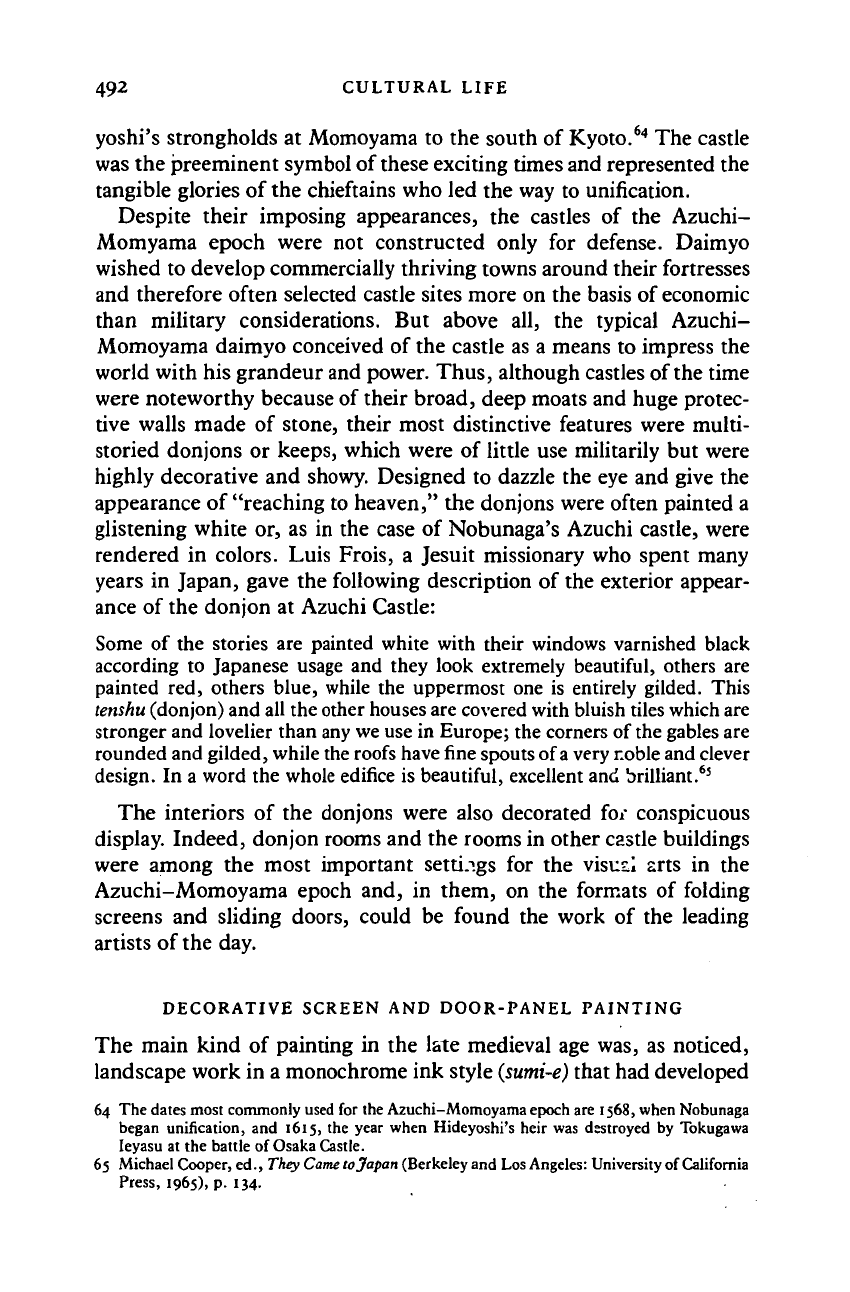
492 CULTURAL LIFE
yoshi's strongholds at Momoyama to the south of Kyoto.
64
The castle
was the preeminent symbol of these exciting times and represented the
tangible glories of the chieftains who led the way to unification.
Despite their imposing appearances, the castles of the Azuchi-
Momyama epoch were not constructed only for defense. Daimyo
wished to develop commercially thriving towns around their fortresses
and therefore often selected castle sites more on the basis of economic
than military considerations. But above all, the typical Azuchi-
Momoyama daimyo conceived of the castle as a means to impress the
world with his grandeur and power. Thus, although castles of the time
were noteworthy because of their broad, deep moats and huge protec-
tive walls made of stone, their most distinctive features were multi-
storied donjons or keeps, which were of little use militarily but were
highly decorative and showy. Designed to dazzle the eye and give the
appearance of "reaching to heaven," the donjons were often painted a
glistening white or, as in the case of Nobunaga's Azuchi castle, were
rendered in colors. Luis Frois, a Jesuit missionary who spent many
years in Japan, gave the following description of the exterior appear-
ance of the donjon at Azuchi Castle:
Some of the stories are painted white with their windows varnished black
according to Japanese usage and they look extremely beautiful, others are
painted red, others blue, while the uppermost one is entirely gilded. This
tenshu
(donjon) and all the other houses are covered with bluish tiles which are
stronger and lovelier than any we use in Europe; the corners of the gables are
rounded and gilded, while the roofs have
fine
spouts of a very noble and clever
design. In a word the whole edifice is beautiful, excellent and brilliant.
65
The interiors of the donjons were also decorated for conspicuous
display. Indeed, donjon rooms and the rooms in other castle buildings
were among the most important settings for the visue.1 arts in the
Azuchi-Momoyama epoch and, in them, on the formats of folding
screens and sliding doors, could be found the work of the leading
artists of the day.
DECORATIVE SCREEN AND DOOR-PANEL PAINTING
The main kind of painting in the late medieval age was, as noticed,
landscape work in a monochrome ink style
(sumi-e)
that had developed
64 The dates most commonly used for the Azuchi-Momoyama epoch are 1568, when Nobunaga
began unification, and 1615, the year when Hideyoshi's heir was destroyed by Tokugawa
Ieyasu at the battle of Osaka Castle.
65 Michael Cooper, ed., They
Came
to Japan (Berkeley and Los Angeles: University of California
Press,
1965), p. 134.
Cambridge Histories Online © Cambridge University Press, 2008
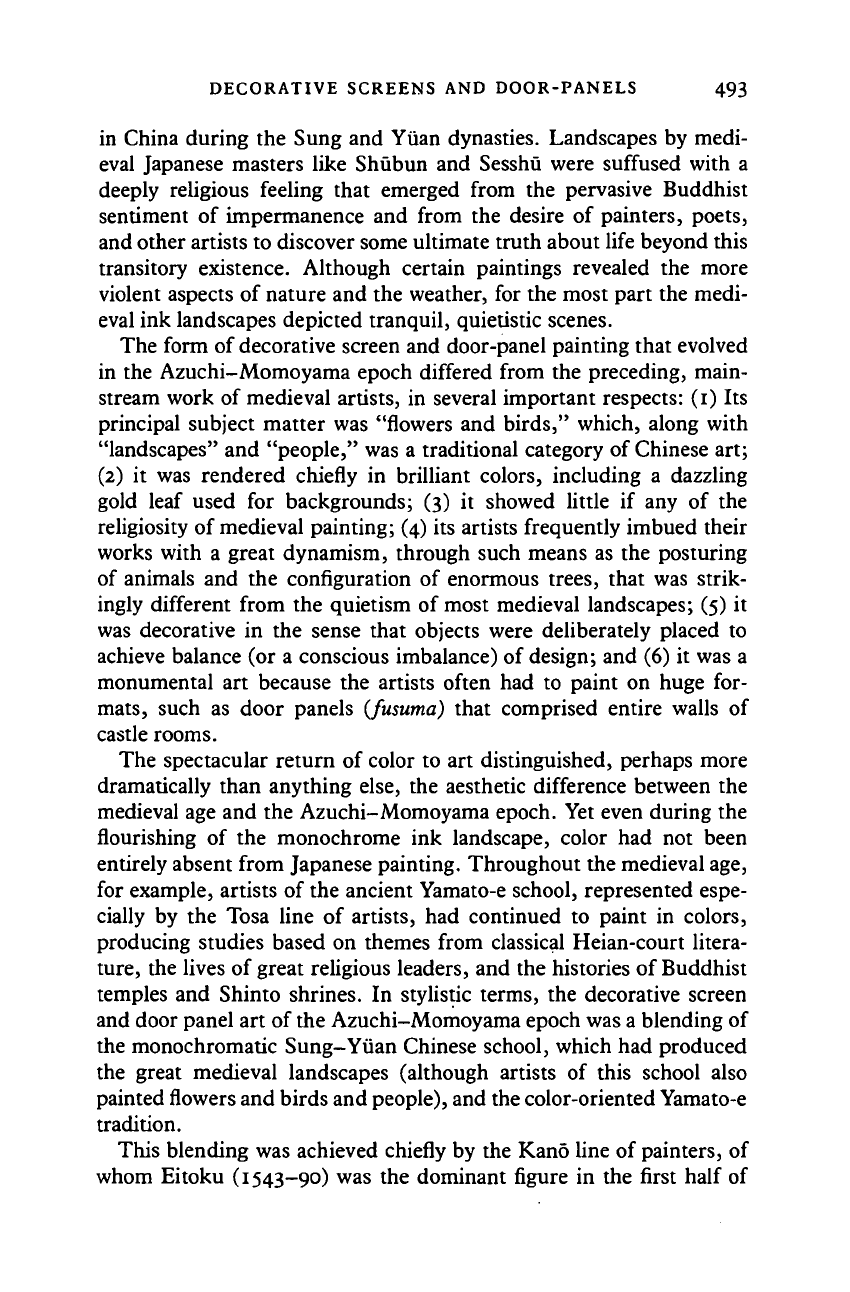
DECORATIVE SCREENS AND DOOR-PANELS 493
in China during the Sung and Yuan dynasties. Landscapes by medi-
eval Japanese masters like Shubun and Sesshu were suffused with a
deeply religious feeling that emerged from the pervasive Buddhist
sentiment of impermanence and from the desire of painters, poets,
and other artists to discover some ultimate truth about life beyond this
transitory existence. Although certain paintings revealed the more
violent aspects of nature and the weather, for the most part the medi-
eval ink landscapes depicted tranquil, quietistic scenes.
The form of decorative screen and door-panel painting that evolved
in the Azuchi-Momoyama epoch differed from the preceding, main-
stream work of medieval artists, in several important respects: (1) Its
principal subject matter was "flowers and birds," which, along with
"landscapes" and "people," was a traditional category of Chinese art;
(2) it was rendered chiefly in brilliant colors, including a dazzling
gold leaf used for backgrounds; (3) it showed little if any of the
religiosity of medieval painting; (4) its artists frequently imbued their
works with a great dynamism, through such means as the posturing
of animals and the configuration of enormous trees, that was strik-
ingly different from the quietism of most medieval landscapes; (5) it
was decorative in the sense that objects were deliberately placed to
achieve balance (or a conscious imbalance) of design; and (6) it was a
monumental art because the artists often had to paint on huge for-
mats,
such as door panels (jusuma) that comprised entire walls of
castle rooms.
The spectacular return of color to art distinguished, perhaps more
dramatically than anything else, the aesthetic difference between the
medieval age and the Azuchi-Momoyama epoch. Yet even during the
flourishing of the monochrome ink landscape, color had not been
entirely absent from Japanese painting. Throughout the medieval age,
for example, artists of the ancient Yamato-e school, represented espe-
cially by the Tosa line of artists, had continued to paint in colors,
producing studies based on themes from classical Heian-court litera-
ture,
the lives of great religious leaders, and the histories of Buddhist
temples and Shinto shrines. In stylistic terms, the decorative screen
and door panel art of the Azuchi-Momoyama epoch was a blending of
the monochromatic Sung-Yuan Chinese school, which had produced
the great medieval landscapes (although artists of this school also
painted flowers and birds and people), and the color-oriented Yamato-e
tradition.
This blending was achieved chiefly by the Kano line of painters, of
whom Eitoku (1543-90) was the dominant figure in the first half of
Cambridge Histories Online © Cambridge University Press, 2008
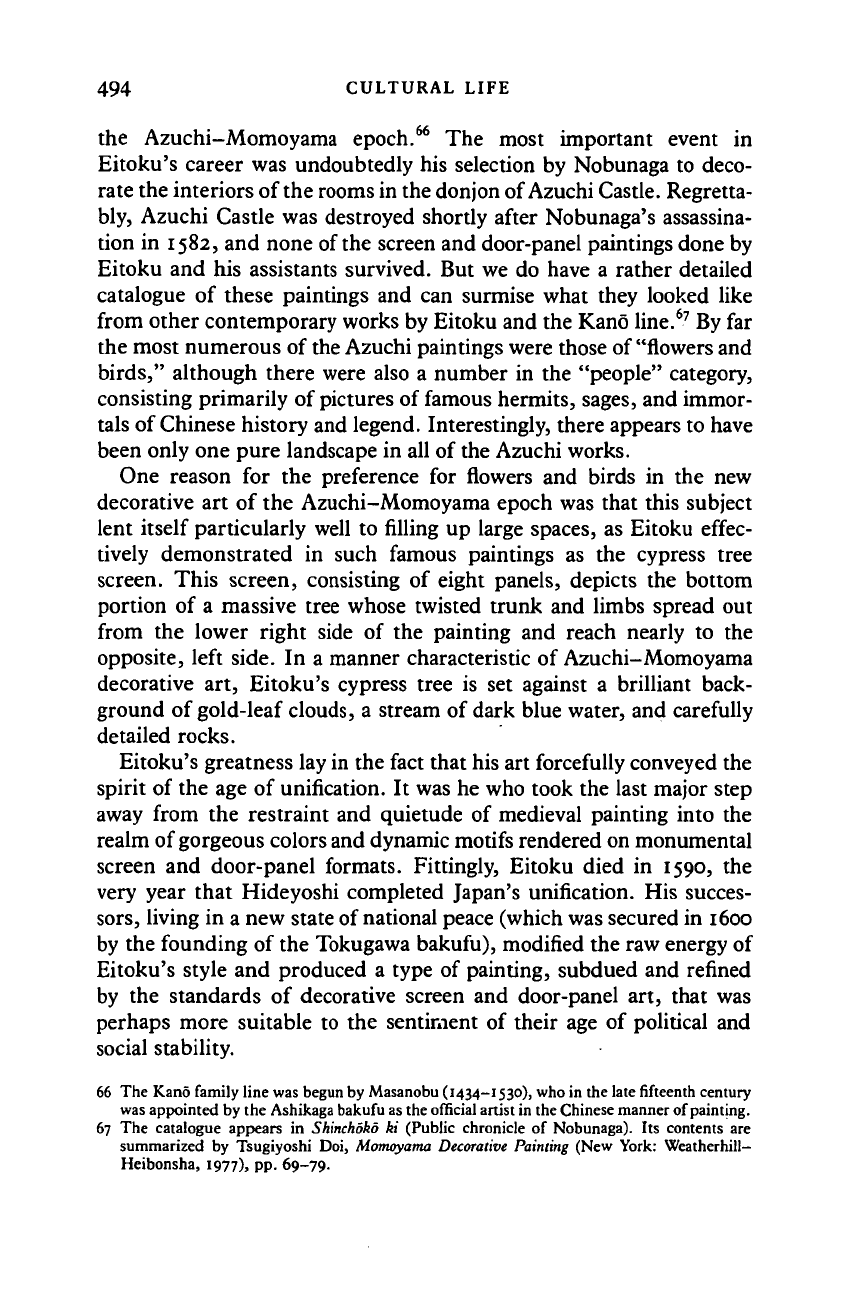
494 CULTURAL LIFE
the Azuchi-Momoyama epoch.
66
The most important event in
Eitoku's career was undoubtedly his selection by Nobunaga to deco-
rate the interiors of the rooms in the donjon of Azuchi
Castle.
Regretta-
bly, Azuchi Castle was destroyed shortly after Nobunaga's assassina-
tion in 1582, and none of the screen and door-panel paintings done by
Eitoku and his assistants survived. But we do have a rather detailed
catalogue of these paintings and can surmise what they looked like
from other contemporary works by Eitoku and the Kano line.
67
By far
the most numerous of the Azuchi paintings were those of "flowers and
birds,"
although there were also a number in the "people" category,
consisting primarily of pictures of famous hermits, sages, and immor-
tals of Chinese history and legend. Interestingly, there appears to have
been only one pure landscape in all of the Azuchi works.
One reason for the preference for flowers and birds in the new
decorative art of the Azuchi-Momoyama epoch was that this subject
lent itself particularly well to filling up large spaces, as Eitoku effec-
tively demonstrated in such famous paintings as the cypress tree
screen. This screen, consisting of eight panels, depicts the bottom
portion of a massive tree whose twisted trunk and limbs spread out
from the lower right side of the painting and reach nearly to the
opposite, left side. In a manner characteristic of Azuchi-Momoyama
decorative art, Eitoku's cypress tree is set against a brilliant back-
ground of gold-leaf clouds, a stream of dark blue water, and carefully
detailed rocks.
Eitoku's greatness lay in the fact that his art forcefully conveyed the
spirit of the age of unification. It was he who took the last major step
away from the restraint and quietude of medieval painting into the
realm of gorgeous colors and dynamic motifs rendered on monumental
screen and door-panel formats. Fittingly, Eitoku died in 1590, the
very year that Hideyoshi completed Japan's unification. His succes-
sors,
living in a new state of national peace (which was secured in 1600
by the founding of the Tokugawa bakufu), modified the raw energy of
Eitoku's style and produced a type of painting, subdued and refined
by the standards of decorative screen and door-panel art, that was
perhaps more suitable to the sentiment of their age of political and
social stability.
66 The Kano family line was begun by Masanobu (1434-1530), who in the late fifteenth century
was appointed by the Ashikaga bakufu as the official artist in the Chinese manner of painting.
67 The catalogue appears in Shinchoko ki (Public chronicle of Nobunaga). Its contents are
summarized by Tsugiyoshi Doi, Momoyama Decorative Painting (New York: Weatherhill-
Heibonsha, 1977), pp. 69-79.
Cambridge Histories Online © Cambridge University Press, 2008
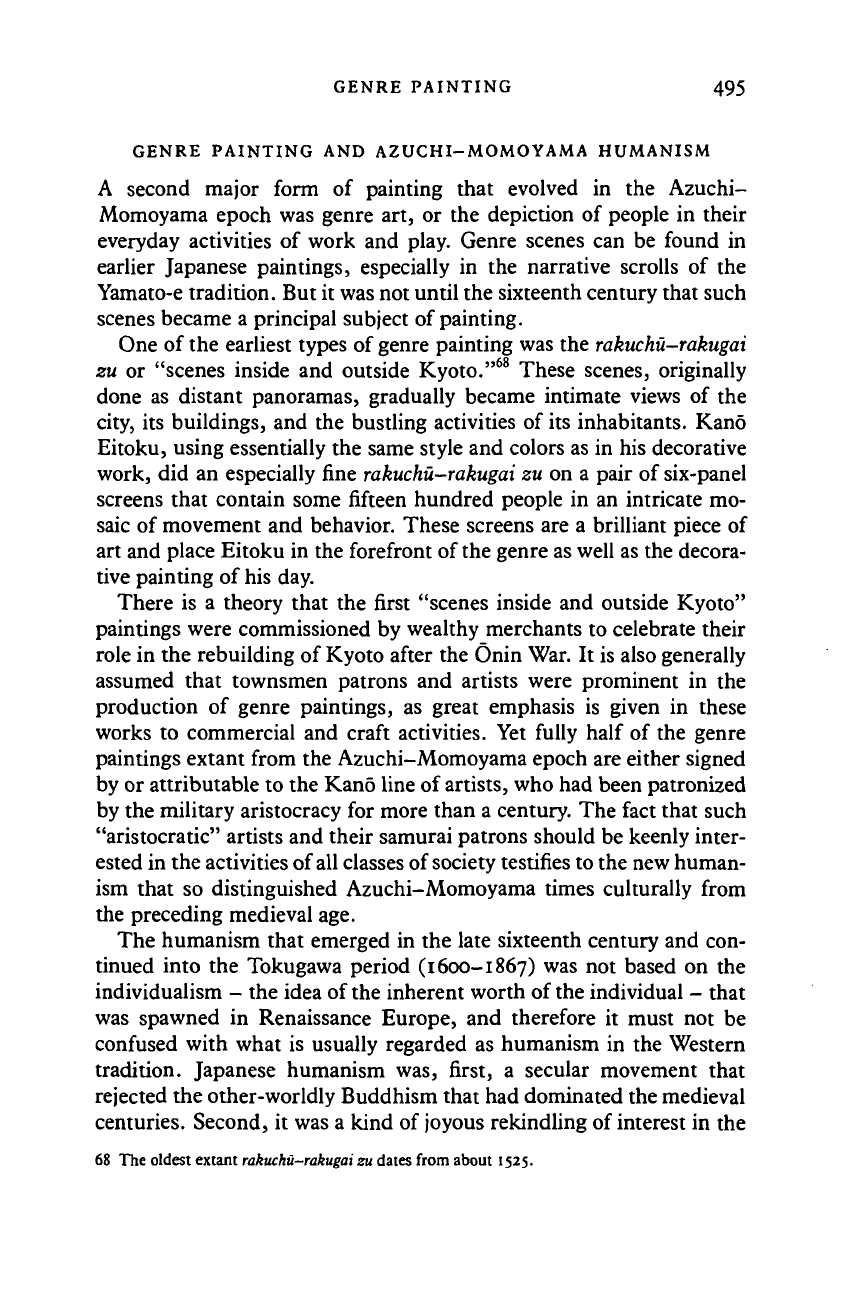
GENRE PAINTING 495
GENRE PAINTING AND AZUCHI-MOMOYAMA HUMANISM
A second major form of painting that evolved in the Azuchi-
Momoyama epoch was genre art, or the depiction of people in their
everyday activities of work and play. Genre scenes can be found in
earlier Japanese paintings, especially in the narrative scrolls of the
Yamato-e tradition. But it was not until the sixteenth century that such
scenes became a principal subject of painting.
One of the earliest types of genre painting was the rakuchu-rakugai
zu or "scenes inside and outside Kyoto."
58
These scenes, originally
done as distant panoramas, gradually became intimate views of the
city, its buildings, and the bustling activities of its inhabitants. Kano
Eitoku, using essentially the same style and colors as in his decorative
work, did an especially fine rakuchu-rakugai zu on a pair of six-panel
screens that contain some fifteen hundred people in an intricate mo-
saic of movement and behavior. These screens are a brilliant piece of
art and place Eitoku in the forefront of the genre as well as the decora-
tive painting of his day.
There is a theory that the first "scenes inside and outside Kyoto"
paintings were commissioned by wealthy merchants to celebrate their
role in the rebuilding of Kyoto after the Onin War. It is also generally
assumed that townsmen patrons and artists were prominent in the
production of genre paintings, as great emphasis is given in these
works to commercial and craft activities. Yet fully half of the genre
paintings extant from the Azuchi-Momoyama epoch are either signed
by or attributable to the Kano line of artists, who had been patronized
by the military aristocracy for more than a century. The fact that such
"aristocratic" artists and their samurai patrons should be keenly inter-
ested in the activities of all classes of society testifies to the new human-
ism that so distinguished Azuchi-Momoyama times culturally from
the preceding medieval age.
The humanism that emerged in the late sixteenth century and con-
tinued into the Tokugawa period (1600-1867) was not based on the
individualism - the idea of the inherent worth of the individual - that
was spawned in Renaissance Europe, and therefore it must not be
confused with what is usually regarded as humanism in the Western
tradition. Japanese humanism was, first, a secular movement that
rejected the other-worldly Buddhism that had dominated the medieval
centuries. Second, it was a kind of joyous rekindling of interest in the
68 The oldest extant rakuchu-rakugai zu dates from about 1525.
Cambridge Histories Online © Cambridge University Press, 2008
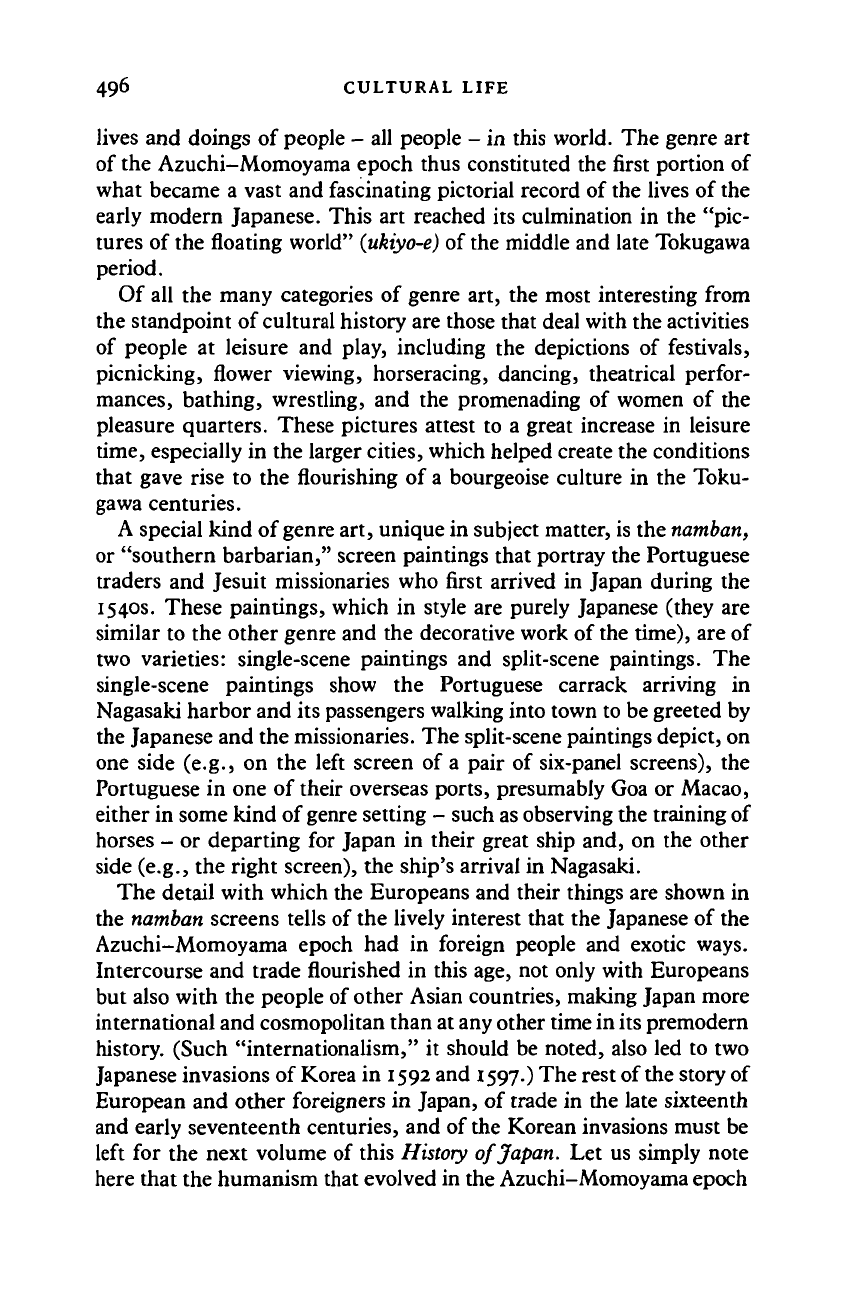
496 CULTURAL LIFE
lives and doings of people - all people - in this world. The genre art
of the Azuchi-Momoyama epoch thus constituted the first portion of
what became a vast and fascinating pictorial record of the lives of the
early modern Japanese. This art reached its culmination in the "pic-
tures of the floating world"
(ukiyo-e)
of the middle and late Tokugawa
period.
Of all the many categories of genre art, the most interesting from
the standpoint of cultural history are those that deal with the activities
of people at leisure and play, including the depictions of festivals,
picnicking, flower viewing, horseracing, dancing, theatrical perfor-
mances, bathing, wrestling, and the promenading of women of the
pleasure quarters. These pictures attest to a great increase in leisure
time,
especially in the larger cities, which helped create the conditions
that gave rise to the flourishing of
a
bourgeoise culture in the Toku-
gawa centuries.
A special kind of genre art, unique in subject matter, is the
namban,
or "southern barbarian," screen paintings that portray the Portuguese
traders and Jesuit missionaries who first arrived in Japan during the
1540s. These paintings, which in style are purely Japanese (they are
similar to the other genre and the decorative work of the time), are of
two varieties: single-scene paintings and split-scene paintings. The
single-scene paintings show the Portuguese carrack arriving in
Nagasaki harbor and its passengers walking into town to be greeted by
the Japanese and the missionaries. The split-scene paintings depict, on
one side (e.g., on the left screen of a pair of six-panel screens), the
Portuguese in one of their overseas ports, presumably Goa or Macao,
either in some kind of genre setting - such as observing the training of
horses - or departing for Japan in their great ship and, on the other
side (e.g., the right screen), the ship's arrival in Nagasaki.
The detail with which the Europeans and their things are shown in
the
namban
screens tells of the lively interest that the Japanese of the
Azuchi-Momoyama epoch had in foreign people and exotic ways.
Intercourse and trade flourished in this age, not only with Europeans
but also with the people of other Asian countries, making Japan more
international and cosmopolitan than at any other time in its premodern
history. (Such "internationalism," it should be noted, also led to two
Japanese invasions of Korea in 1592 and 1597.) The rest of
the
story of
European and other foreigners in Japan, of trade in the late sixteenth
and early seventeenth centuries, and of the Korean invasions must be
left for the next volume of this
History
of Japan. Let us simply note
here that the humanism that evolved in the Azuchi-Momoyama epoch
Cambridge Histories Online © Cambridge University Press, 2008
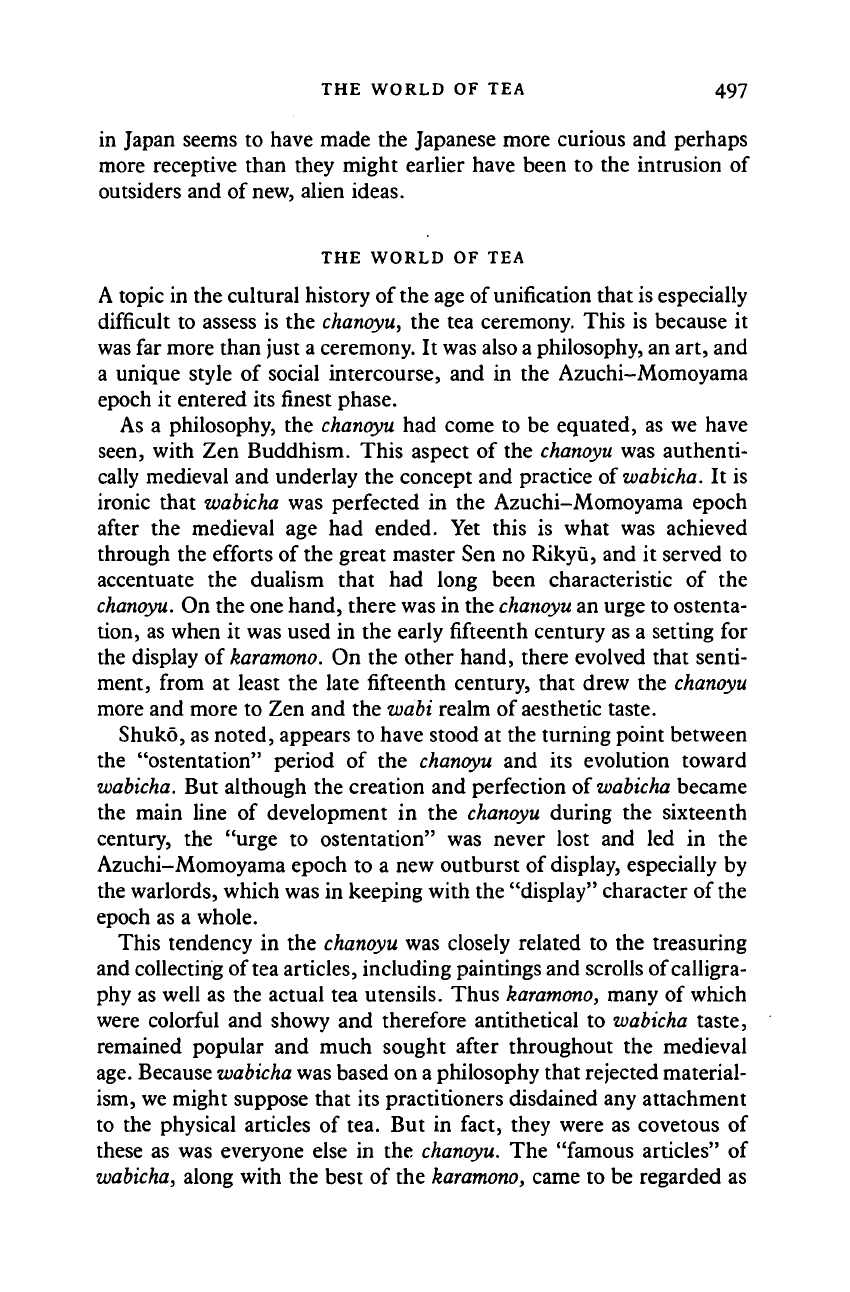
THE WORLD OF TEA 497
in Japan seems to have made the Japanese more curious and perhaps
more receptive than they might earlier have been to the intrusion of
outsiders and of new, alien ideas.
THE WORLD OF TEA
A topic in the cultural history of the age of unification that is especially
difficult to assess is the chanoyu, the tea ceremony. This is because it
was far more than just a ceremony. It was also a philosophy, an art, and
a unique style of social intercourse, and in the Azuchi-Momoyama
epoch it entered its finest phase.
As a philosophy, the chanoyu had come to be equated, as we have
seen, with Zen Buddhism. This aspect of the chanoyu was authenti-
cally medieval and underlay the concept and practice of wabicha. It is
ironic that wabicha was perfected in the Azuchi-Momoyama epoch
after the medieval age had ended. Yet this is what was achieved
through the efforts of the great master Sen no Rikyu, and it served to
accentuate the dualism that had long been characteristic of the
chanoyu. On the one hand, there was in the
chanoyu
an urge to ostenta-
tion, as when it was used in the early fifteenth century as a setting for
the display of
karamono.
On the other hand, there evolved that senti-
ment, from at least the late fifteenth century, that drew the chanoyu
more and more to Zen and the wabi realm of aesthetic taste.
Shuko, as noted, appears to have stood at the turning point between
the "ostentation" period of the chanoyu and its evolution toward
wabicha. But although the creation and perfection of wabicha became
the main line of development in the chanoyu during the sixteenth
century, the "urge to ostentation" was never lost and led in the
Azuchi-Momoyama epoch to a new outburst of display, especially by
the warlords, which was in keeping with the "display" character of the
epoch as a whole.
This tendency in the chanoyu was closely related to the treasuring
and collecting of tea articles, including paintings and scrolls of calligra-
phy as well as the actual tea utensils. Thus karamono, many of which
were colorful and showy and therefore antithetical to wabicha taste,
remained popular and much sought after throughout the medieval
age.
Because wabicha was based on a philosophy that rejected material-
ism, we might suppose that its practitioners disdained any attachment
to the physical articles of tea. But in fact, they were as covetous of
these as was everyone else in the chanoyu. The "famous articles" of
wabicha, along with the best of the karamono, came to be regarded as
Cambridge Histories Online © Cambridge University Press, 2008
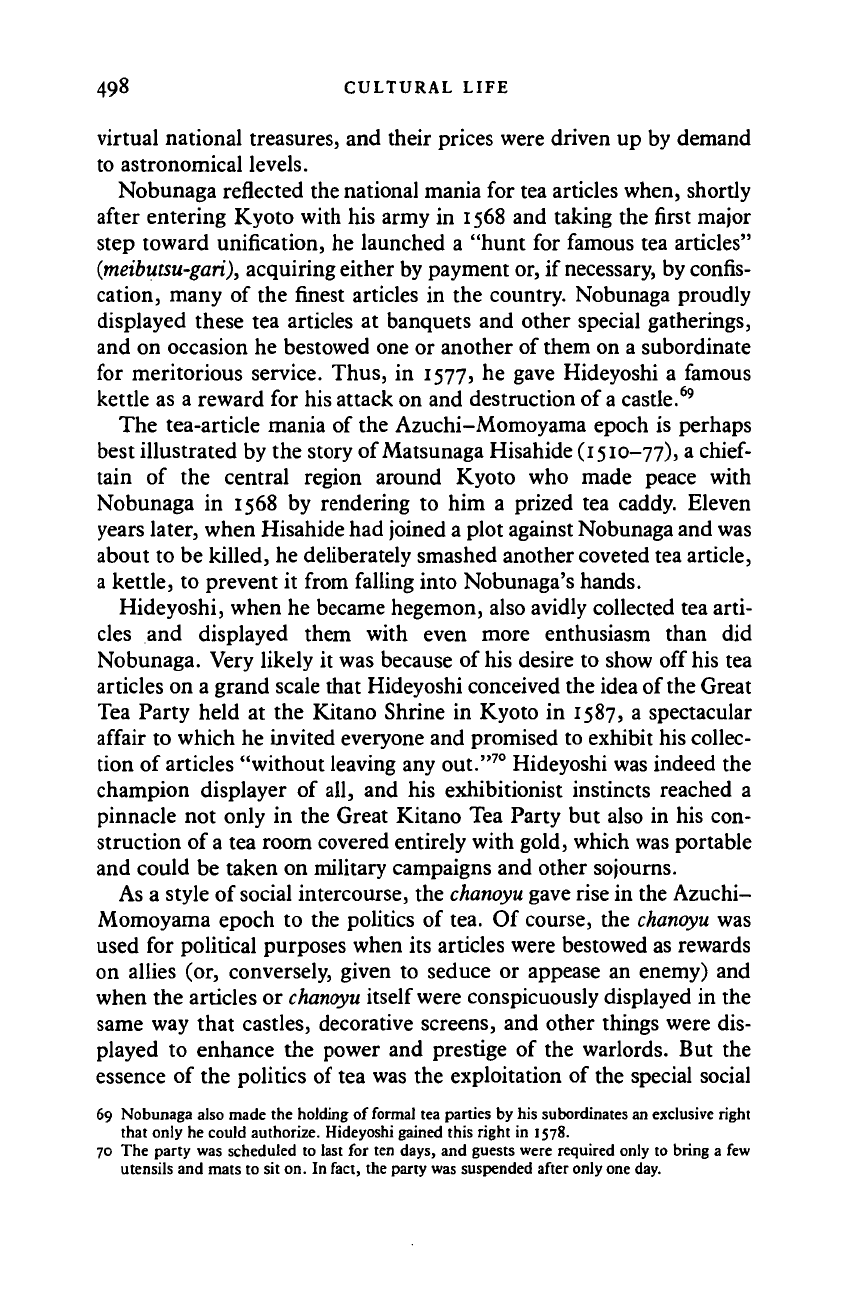
498 CULTURAL LIFE
virtual national treasures, and their prices were driven up by demand
to astronomical levels.
Nobunaga reflected the national mania for tea articles when, shortly
after entering Kyoto with his army in 1568 and taking the first major
step toward unification, he launched a "hunt for famous tea articles"
(meibutsu-gari),
acquiring either by payment or, if
necessary,
by confis-
cation, many of the finest articles in the country. Nobunaga proudly
displayed these tea articles at banquets and other special gatherings,
and on occasion he bestowed one or another of them on a subordinate
for meritorious service. Thus, in 1577, he gave Hideyoshi a famous
kettle as a reward for his attack on and destruction of
a
castle.
69
The tea-article mania of the Azuchi-Momoyama epoch is perhaps
best illustrated by the story of Matsunaga Hisahide (1510-77), a
chief-
tain of the central region around Kyoto who made peace with
Nobunaga in 1568 by rendering to him a prized tea caddy. Eleven
years later, when Hisahide had joined a plot against Nobunaga and was
about to be killed, he deliberately smashed another coveted tea article,
a kettle, to prevent it from falling into Nobunaga's hands.
Hideyoshi, when he became hegemon, also avidly collected tea arti-
cles and displayed them with even more enthusiasm than did
Nobunaga. Very likely it was because of his desire to show off his tea
articles on a grand scale that Hideyoshi conceived the idea of
the
Great
Tea Party held at the Kitano Shrine in Kyoto in 1587, a spectacular
affair to which he invited everyone and promised to exhibit his collec-
tion of articles "without leaving any out."
70
Hideyoshi was indeed the
champion displayer of all, and his exhibitionist instincts reached a
pinnacle not only in the Great Kitano Tea Party but also in his con-
struction of
a
tea room covered entirely with gold, which was portable
and could be taken on military campaigns and other sojourns.
As a style of
social
intercourse, the
chanoyu
gave rise in the Azuchi-
Momoyama epoch to the politics of tea. Of course, the
chanoyu
was
used for political purposes when its articles were bestowed as rewards
on allies (or, conversely, given to seduce or appease an enemy) and
when the articles or
chanoyu
itself were conspicuously displayed in the
same way that castles, decorative screens, and other things were dis-
played to enhance the power and prestige of the warlords. But the
essence of the politics of tea was the exploitation of the special social
69 Nobunaga also made the holding of formal tea parties by his subordinates an exclusive right
that only he could authorize. Hideyoshi gained this right in 1578.
70 The party was scheduled to last for ten days, and guests were required only to bring a few
utensils and mats to sit on. In fact, the party was suspended after only one day.
Cambridge Histories Online © Cambridge University Press, 2008
